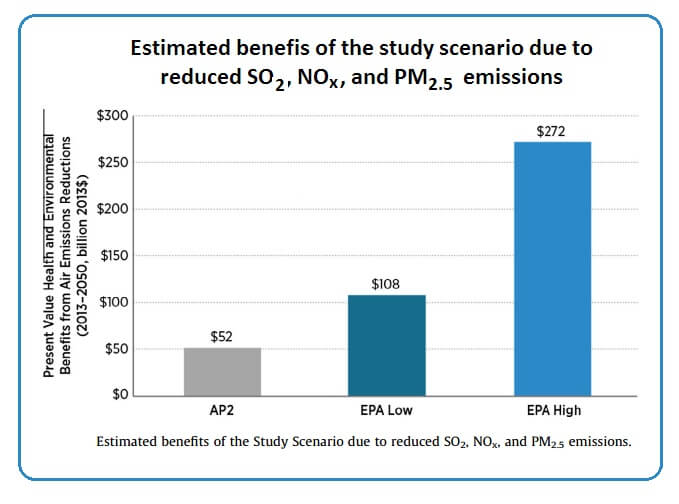This report from the DOE’s Berkeley Labs examines the potential benefits and secondary impacts of wind generated power providing 35% of electricity by 2050. The abstract and introduction are here. Highlights include:
- Scenarios that yield potential greenhouse-gas benefits of $85 billion to $1,230 billion.
- Air-pollution-related health benefits are estimated at $52 billion to $272 billion.
- Reductions in electric-sector water use, 15% reduction in withdrawals and 23% cut in
- Implications for risk of energy supply, local economic development, and land use.
The report abstract
We (report authors) model scenarios of the U.S. electric sector in which wind generation reaches 10% of end-use electricity demand in 2020, 20% in 2030, and 35% in 2050. As shown in a companion paper, ($41.95 available online here) achieving these penetration levels would have significant implications for the wind industry and the broader electric sector.
 Compared to a baseline that assumes no new wind deployment, under the primary scenario modeled, achieving these penetrations imposes an incremental cost to electricity consumers of less than 1% through 2030. These cost implications, however, should be balanced against the variety of environmental and social implications of such a scenario.
Compared to a baseline that assumes no new wind deployment, under the primary scenario modeled, achieving these penetrations imposes an incremental cost to electricity consumers of less than 1% through 2030. These cost implications, however, should be balanced against the variety of environmental and social implications of such a scenario.
Relative to a baseline that assumes no new wind deployment, the analysis shows that the high-penetration wind scenario yields potential greenhouse-gas benefits of $85 billion to $1,230 billion in present-value terms, with a central estimate of $400 billion. Air-pollution-related health benefits are estimated at $52 billion to $272 billion, while annual electric-sector water withdrawals and consumption are lower by 15% and 23% in 2050, respectively.
We also find that a high-wind-energy future would have implications for the diversity and risk of energy supply, local economic development, and land use and related local impacts on communities and ecosystems; however, these additional impacts may not greatly affect aggregate social welfare owing to their nature, in part, as resource transfers.
The introduction
Wind energy’s role in global and U.S. electricity supply is rising, driven by policy measures as well as technology advancements and associated cost reductions. The underlying policies helping motivate growth in wind energy are often predicated on the stated benefits of wind energy relative to fossil energy sources, including carbon and air-pollution emissions reductions, limited or no water requirements, potential benefits from energy diversity and risk reduction, and local economic-development activity.
These benefits, however, are not always evaluated quantitatively, described fully, or qualified appropriately. Moreover, wind’s benefits must be compared with the potential costs and risks introduced by adding wind energy to the electric system—such as changes in energy costs and increased planning and operating reserve requirements—as well as the potential negative impacts of wind on local ecosystems, local communities, and economic development elsewhere in the economy.
Transitioning to a future electricity system in which wind plays a more prominent role will have direct and significant impacts on the wind industry, cascading effects through the rest of the electricity system, and implications for local and global environments, human health, and the broader economy. In this and a companion paper we evaluate these myriad potential impacts, costs, and benefits within the context of a Wind Vision scenario in which wind energy increases from its 2013 contribution of 4.5% of U.S. annual electricity demand to 10% by 2020, 20% by 2030, and 35% by 2050. As described in DOE, we view this modeled scenario as plausible but ambitious. We then compare this scenario with an alternative baseline scenario that assumes no new wind deployment.
The analysis described here assesses the potential implications of achieving a high-wind future. Lantz et al. and DOE summarize the electric-sector modeling approach and its advantages and limitations, the scenario framework, and the key input assumptions; the envisioned transitions to future power systems based on scenario results; direct electric-sector costs and impacts on electricity consumers; and transmission-expansion and grid-integration needs.
The current paper analyzes a subset of the possible environmental and social co-benefits, co-costs, and co-impacts of this high-wind scenario. Specifically, it covers greenhouse-gas emissions reductions, air-pollution impacts, water-use reduction, energy diversity and risk reduction, workforce and economic-development impacts, and land-use and local impacts.
For the full article: http://www.sciencedirect.com/science/article/pii/S0306261916308984
Filed Under: News




